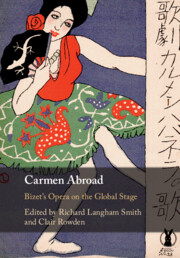Book contents
- Carmen Abroad
- Carmen Abroad
- Copyright page
- Contents
- Figures
- Tables
- Preface
- Acknowledgements
- Notes on Contributors
- Part I Establishment in Paris and the Repertoire
- Part II Across Frontiers
- 7 A New Performance for the New World: Carmen in America
- 8 The Unstoppable March of Time: Carmen, and New Orleans in Transition
- 9 The Return of the Habanera: Carmen’s Early Reception in Latin America
- 10 From Spain to Lusophone Lands: Carmen in Portugal and Brazil
- 11 Carmen in the Antipodes
- 12 Carmen, as Seen and Heard in Victorian Britain
- 13 Celtic Carmens: Rebellion and Redemption
- 14 Carmen for the Czechs and Germans, 1880 to 1945
- 15 Carmen in Poland prior to 1918
- 16 A Woman or a Demon: Carmen in the Late Nineteenth-Century Nordic Countries
- Part III Localising Carmen
- Selected Bibliography
- Index
- References
7 - A New Performance for the New World: Carmen in America
from Part II - Across Frontiers
Published online by Cambridge University Press: 18 September 2020
- Carmen Abroad
- Carmen Abroad
- Copyright page
- Contents
- Figures
- Tables
- Preface
- Acknowledgements
- Notes on Contributors
- Part I Establishment in Paris and the Repertoire
- Part II Across Frontiers
- 7 A New Performance for the New World: Carmen in America
- 8 The Unstoppable March of Time: Carmen, and New Orleans in Transition
- 9 The Return of the Habanera: Carmen’s Early Reception in Latin America
- 10 From Spain to Lusophone Lands: Carmen in Portugal and Brazil
- 11 Carmen in the Antipodes
- 12 Carmen, as Seen and Heard in Victorian Britain
- 13 Celtic Carmens: Rebellion and Redemption
- 14 Carmen for the Czechs and Germans, 1880 to 1945
- 15 Carmen in Poland prior to 1918
- 16 A Woman or a Demon: Carmen in the Late Nineteenth-Century Nordic Countries
- Part III Localising Carmen
- Selected Bibliography
- Index
- References
Summary
Despite a mixed critical reception after Carmen’s American premiere in New York City on 23 October 1878, the opera quickly became a mainstay of the repertoire in the United States. American reviewers described Carmen as wicked yet compellingly seductive, Micaëla as a paragon of virtue and Don José as a stereotypically violent but manly Spaniard. They framed the opera as a cautionary tale of the dire consequences when women abandoned their traditional social roles. A close reading of the performing materials rented to American opera companies in the late-nineteenth and early twentieth centuries by the Tams-Witmark Company reveals a performance tradition for Carmen which responded to and exaggerated the early critical reactions towards the main characters. Opera troupes used a combination of carefully placed cuts and stage pantomimes to perform an interpretation of the work that subtly tailored Bizet’s music to the American audience, which intensified Carmen’s vicious tendencies, highlighted Micaëla’s femininity and amplified Don José’s masculinity. The modifications to Carmen offer a case study that illustrates American operatic performance practices and illuminates issues of adaptation and cultural transfer in the transatlantic journey of European music to the United States.
Keywords
- Type
- Chapter
- Information
- Carmen AbroadBizet's Opera on the Global Stage, pp. 113 - 129Publisher: Cambridge University PressPrint publication year: 2020
References
Newspapers and Periodical Literature
Boston Daily Advertiser
Boston Herald
Chicago Daily Tribune
New York Times
Music (Chicago)
The North American (Philadelphia)
Philadelphia Inquirer
The Post (Boston)

